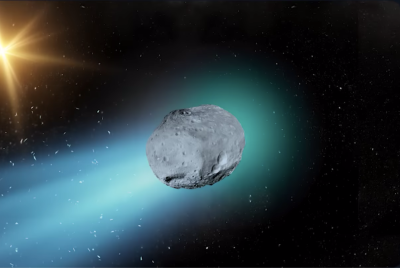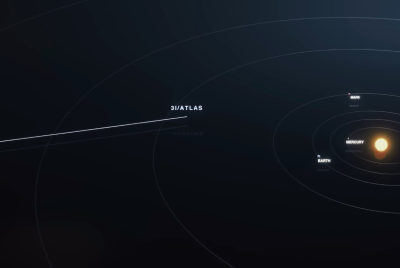ESA JUICE Images: Comet 3I/ATLAS Photos Trapped Until February 2026
ESA's JUICE mission captures interstellar comet images, but solar heat delays release until 2026.

Imagine a silent, alien messenger drifting into our cosmic neighbourhood, offering a glimpse of material untouched since the birth of stars. This is comet 3I/ATLAS, a mysterious visitor from deep interstellar space that has recently put on a spectacular show for astronomers across our Solar System.
Since its initial discovery on 1 July, 2023, by the Asteroid Terrestrial-impact Last Alert System (ATLAS), this transient rock has been the target of nearly every major eye in space—from NASA's orbiters to China's Tianwen-1 spacecraft circling Mars.
The excitement peaked when the European Space Agency's (ESA) high-tech Jupiter Icy Moons Explorer (JUICE) mission confirmed it captured images of the comet while en route to the gas giant. However, this is where the plot thickens: due to a critical piece of operational necessity, the highly anticipated images are essentially 'trapped' onboard the spacecraft and won't be seen by the public for well over two years.
The resulting stream of raw imagery and data from various sources has been impressive, particularly the batch released by NASA, which included observations taken even during the lengthy US government shutdown.
These results captured the object across various wavelengths, including ultraviolet from NASA's MAVEN (Mars Atmosphere and Volatile EvolutioN) orbiter and complementary observations from the joint ESA/NASA SOHO mission.
However, one specific observation stood out for its sheer novelty: the images grabbed by NASA's Perseverance Rover. This feat marked a momentous occasion, representing the first time an interstellar comet was photographed from the surface of another world.
NASA confirmed the details: 'The closest imagery of the comet was taken by NASA's spacecraft at Mars. Earlier this fall, 3I/ATLAS passed by Mars from a distance of 19 million miles, where it was observed by three NASA spacecraft. The Mars Reconnaissance Orbiter (MRO) captured one of the closest images of the comet, while the MAVEN (Mars Atmosphere and Volatile EvolutioN) orbiter obtained ultraviolet images that will help scientists understand the comet's make-up', NASA explained.
'Meanwhile, the Perseverance rover grabbed a faint glimpse from the surface of Mars.'
☄️ Comet #3I/ATLAS is currently making its closest approach to the Sun.@ESA_Juice might catch the best view of this comet in a very active state. Juice will attempt observations in November 2025, with data received on Earth in February 2026 👉 https://t.co/F5fhuSSdal
— ESA Science (@esascience) October 30, 2025
Follow… pic.twitter.com/tvXSaN4u9m
Catching the Interstellar Comet 3I/ATLAS on the Way to Jupiter
While the Martian surface photos are undeniably cool, the international science community is arguably most excited about the images captured closer to the Solar System's largest planet.
Between 2 November and 25 November, the European Space Agency's JUICE (Jupiter Icy Moons Explorer) spacecraft successfully observed the comet. This opportunity was completely unexpected and serendipitous, as it occurred while the probe was in its long cruise phase towards Jupiter.
Olivier Witasse, ESA Project Scientist, emphasised the surprise and good fortune of the planning: 'All this campaign was unexpected for everybody! For JUICE, indeed, we are in a cruise phase during which there are thermal constraints, being relatively close to the Sun (with respect to the science phase around Jupiter).
Therefore, no payload activities were expected to take place at this moment. However, given the uniqueness of these observations, it was decided to prepare this extra observation planning.'
This required a significant logistical effort, despite the great distance involved. Witasse elaborated on the instruments commissioned for the remote sensing observations: 'JUICE will observe 3I/ATLAS between 2 and 25 November.We will be using five instruments: the camera, the near-infrared imaging instrument, the UV spectrometer, the sub-millimetre instrument, and a sensor to image neutral atoms. We are far away (0.5 astronomical units), therefore, only remote sensing.'
The simultaneous use of multiple sensors will provide an unprecedented compositional profile of the comet, provided the data can be recovered.
Why JUICE Images Are Stuck Until 2026
Unfortunately, those images won't be gracing our screens anytime in the near future. We face a significant wait—specifically, until February 2026. This extensive delay is not part of a technical fault or a conspiracy; it is a direct result of the spacecraft's necessary thermal management and self-protection protocols.
ESA clarified the situation regarding the data downlink: 'As JUICE is currently close to the Sun, it is using its main high-gain antenna as a heat shield. It is using its smaller medium-gain antenna to send data back to Earth at a much lower rate.'
The combined effects of a severely limited data rate and the spacecraft's current location—on the far side of the Sun from Earth—mean the images are currently 'trapped' onboard.
This same thermal constraint reasoning was previously applied during a gravity assist manoeuvre. As ESA explained in a separate statement: 'Designed for the cold, dark environment of Jupiter, JUICE must adapt to the intense solar heat near Venus. To protect its sensitive components, the spacecraft is using its main, high-gain antenna as a thermal shield', they noted.
'Due to thermal constraints, its remote sensing instruments cannot be active during the flyby, and so no images of Venus will be captured.' While the wait for the JUICE data is frustrating, future missions may soon make comet interception easier. Following the success of ESA's Rosetta mission, which famously landed on Comet 67P in 2014, the agency is developing the Comet Interceptor.
This next-generation mission is designed to visit a pristine, long-period comet, or potentially even another rare interstellar visitor, carrying material 'untouched since the dawn of the Solar System'. The hope is that missions like Comet Interceptor will one day eliminate the need for such extensive waiting periods.
'It is also possible – though very unlikely given their rarity – that Comet Interceptor could visit an interstellar comet.'
© Copyright IBTimes 2025. All rights reserved.





















